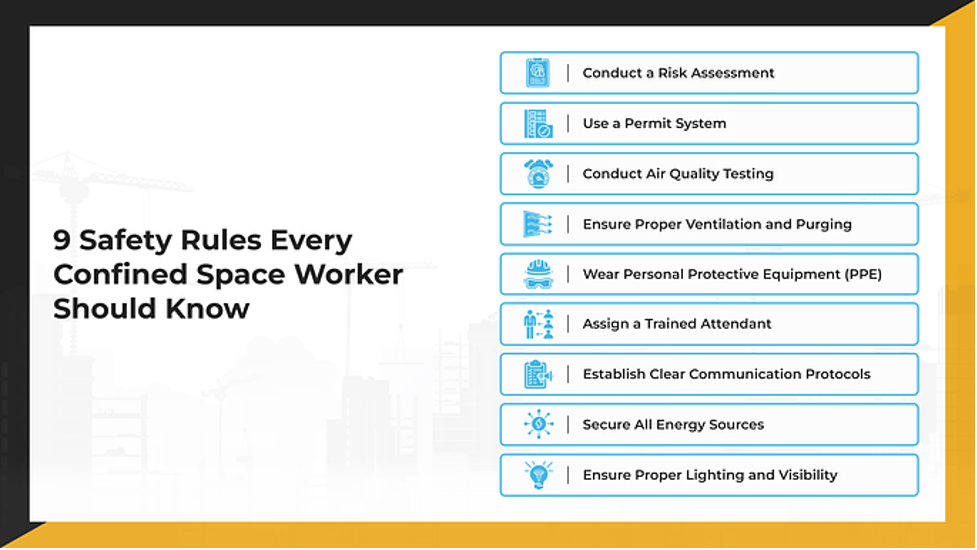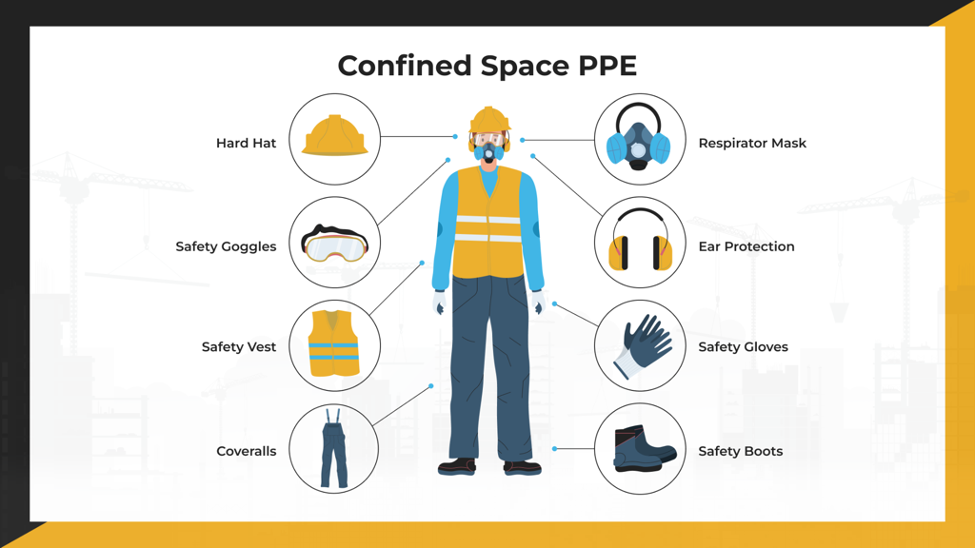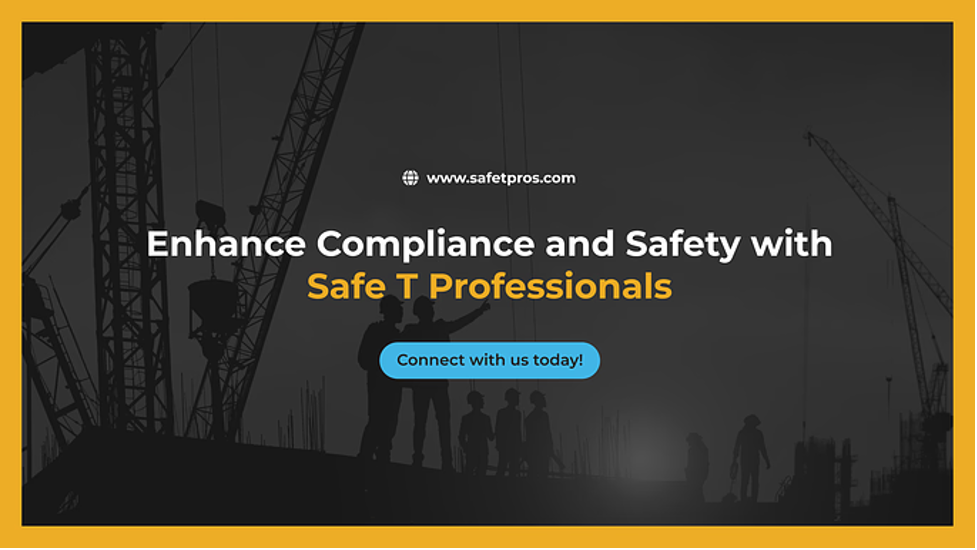Confined spaces are common in many industries, including construction, utilities, manufacturing, and maintenance. While they may seem harmless at first glance, these environments can change quickly and introduce unexpected hazards that put workers at serious risk.
According to the Occupational Safety and Health Administration (OSHA), a confined space is an area that is large enough for a worker to enter, has limited or restricted means of entry or exit, and is not designed for continuous occupancy. The National Institute for Occupational Safety and Health (NIOSH) defines it similarly but also emphasizes the need for special precautions due to increased risk factors.
Whether it’s a tank, tunnel, sewer, or storage silo, the unique conditions of confined spaces, limited access, restricted airflow, and the potential presence of toxic or flammable substances require a careful, methodical approach to safety.
Often, the danger isn’t apparent until work begins. Tasks like welding, cleaning, or inspection can trigger chemical reactions, displace oxygen, or release hazardous vapors.
Understanding the risks is the first step. Having a plan, the right equipment, and trained personnel makes all the difference between a routine job and a life-threatening emergency.
In this blog, we’ll walk through what qualifies as a confined space, the hidden dangers that can arise, and the essential safety protocols every employer and worker should follow to stay compliant and safe.
Types of Hazards Associated with Confined Spaces
| Type of Hazard | Description | Examples/Details |
| Atmospheric Hazards | Hazards related to air quality can lead to immediate health risks or death. | ✔️ Toxic gases: Hydrogen sulfide (H₂S), carbon monoxide (CO)
✔️ Oxygen-deficient environments (e.g., rust consuming oxygen) ✔️ Flammable vapors ✔️ Invisible threats present even when the air looks clear |
| Physical Hazards | Hazards from the physical environment or mechanical conditions within the space. | ✔️ Engulfment by sand, grains, liquids
✔️ Moving machinery not properly locked out ✔️ Electrical shock risk ✔️ Sharp edges, extreme temperatures ✔️ Restricted movement causing slips or falls |
| Operational Hazards | The nature of the work or working conditions inside the confined space creates hazards. | ✔️ Poor visibility or lighting
✔️ Limited space for movement ✔️ Communication barriers between inside and outside ✔️ Delayed emergency response ✔️ Difficult evacuation |
OSHA Requirements for Confined Space Safety: What Employers Must Follow
Permit-Required Confined Spaces
The Occupational Safety and Health Administration (OSHA) regulation 29 CFR 1910.146 covers permit-required confined spaces (PRCS) in general industry. It establishes requirements to protect employees from the hazards associated with working in confined spaces.
OSHA classifies confined spaces into two categories: permit-required and non-permit. Permit-required confined spaces (PRCS) have one or more of the following hazards:
- Hazardous atmosphere
- Material that could engulf an entrant
- Internal configuration that could trap or asphyxiate
- Any other recognized serious safety or health hazard.
Employers must implement a complete permit system before anyone enters these spaces. This includes hazard assessment, entry permits, communication plans, and rescue procedures.
Non-permit confined spaces are confined spaces that do not contain or, with proper precautions, cannot contain hazards capable of causing death or serious physical harm. These spaces still
require awareness and safe practices, but a permit system is not mandatory.
The regulation is meant to prevent accidents such as toxic exposure, engulfment, and suffocation by ensuring a structured approach to working in these high-risk areas. It applies to most general industry workplaces and is separate from construction-specific rules, which fall under 29 CFR 1926 Subpart AA.
Employer Responsibilities
You are responsible for making sure all confined space work in your facility is done safely and meets OSHA standards. This means identifying confined spaces, assessing risks, and informing both your team and contractors about the dangers.
You need to put a written permit program in place, supply the right equipment, and ensure only trained workers enter. A rescue plan must be documented, and rescue services must be ready. Regular checks, updates to procedures, and close coordination with contractors are also part of your role. Doing this helps you prevent serious incidents and protect everyone involved.
Training and Certification Requirements
Employees involved in confined space operations must receive job-specific training before starting work. This includes:
- Identifying permit and non-permit spaces
- Recognizing hazards and signs of exposure
- Using air monitoring devices and PPE correctly
- Following entry, work, and exit procedures
- Understanding emergency protocols and rescue plans
Training must be provided to authorized entrants, attendants, and entry supervisors, each of whom has different roles and responsibilities. Workers must be retrained whenever there is a change in the process, if there are deviations from procedures, or if there are knowledge gaps.
Documentation of all training sessions is required. Employers must maintain records that show the names of trained workers, the dates of training, and the content covered.
Documentation and Signage Standards
Proper documentation and signage are critical for compliance and safety. Employers must maintain a written permit space program that outlines procedures for safe entry and exit, as well as rescue. Use a standardized entry permit form that records test results, entry time limits, authorized personnel, equipment used, and emergency contacts.
Keep completed permits for at least one year for auditing and review. Post clear signage at the entrance of all permit-required confined spaces. Signs should include phrases like Danger — Permit-Required Confined Space. Do Not Enter.
Signage must be visible, legible, and placed in a way that alerts workers before they attempt to enter. This helps prevent accidental or unauthorized entry and emphasizes the seriousness of the hazards.
9 Safety Rules Every Confined Space Worker Should Know
Here is the list of essential tips that workers must follow before entering confined spaces:
1. Conduct a Risk Assessment
A risk assessment must be done before anyone enters a confined space. This process identifies all possible hazards that could harm workers during entry, work, or exit.
Check for atmospheric dangers (such as low oxygen or toxic gases), physical hazards (like moving parts or engulfment risks), and operational concerns (like electrical equipment or sharp objects). Look at the records of previous work in the same space. Past incidents, repairs, or hazard reports can point to potential problems. Inspect all entry and exit locations. Determine whether they allow quick entry and escape. Narrow or obstructed openings make rescue difficult and increase the overall risk level.
2. Use a Permit System
Permit systems are mandatory for permit-required confined spaces. The permit authorizes safe entry and confirms that all safety measures are in place.
A proper entry permit must list all identified hazards and specify the exact start and end times of the work to minimize exposure to them. It should include the names of all authorized personnel involved—entrants, attendants, and supervisors, as well as the required personal protective equipment (PPE), such as respirators, harnesses, helmets, and gloves.
The permit must also document initial air quality test results for oxygen, toxic gases, and flammable vapors, specify the type and duration of ventilation used, and outline a detailed rescue plan with emergency contacts and response procedures.
Only trained and authorized workers can issue and work under a permit. The permit must be reviewed and signed before entry begins, and it should be canceled immediately once the work is done or if the conditions change.
3. Conduct Air Quality Testing
Air inside a confined space must be tested before entry and monitored continuously during the job. Use calibrated gas detectors to measure gas detection. Here is the list of required parameters for gas detection used in confined space safety:
| Gas | Safe/Threshold Level | Remarks |
| Oxygen (O₂) | 19.5% – 23.5% | Below 19.5% is oxygen-deficient; above 23.5% increases fire risk |
| Carbon Monoxide (CO) | Toxic above 35 ppm | Colorless, odorless, and can cause poisoning at high levels |
| Hydrogen Sulfide (H₂S) | Dangerous above 10 ppm | Smells like rotten eggs; quickly deadens the sense of smell; highly toxic |
| Lower Explosive Limit (LEL) | Must remain below 10% of LEL | Indicates presence of flammable gases or vapors; risk of explosion above 10% |
Always test the atmosphere from the top, middle, and bottom of the space since gases can settle at different levels depending on their weight. Atmospheric conditions can change quickly. Monitors must remain on during the entire entry. If hazardous levels are detected, workers must evacuate immediately.
4. Ensure Proper Ventilation and Purging
Ventilation is crucial for making confined spaces safe by removing harmful gases and introducing fresh air. Mechanical ventilation, using blowers or exhaust fans, is the most effective method, offering better airflow control. Natural ventilation, such as opening hatches or doors, is less reliable and should only be used in low-risk situations with expert approval.
Always ventilate before entry, especially if hazardous materials were previously stored or if air tests fail. The duration depends on the space, ventilation type, and hazard level. If purging is needed, use inert gases or steam carefully to avoid new risks like oxygen displacement.
5. Wear Personal Protective Equipment (PPE)
PPE should be selected based on the specific hazards identified during the risk assessment.
- Respirators: If air quality is poor or there’s a risk of toxic gas exposure, appropriate respirators are required. These may be air-purifying or supplied-air types depending on the hazard level.
- Full-body Harness: A harness is needed for rescue purposes. It should be connected to a lifeline if the space permits, allowing for non-entry rescue in emergencies.
- Gloves and protective clothing protect against chemical exposure, sharp surfaces, and heat. The material should match the type of hazard (e.g., rubber for chemicals, leather for heat or abrasions).
- Helmets: Head protection is essential to prevent injury from falling objects or contact with overhead structures.
- Communication Gear: Workers should carry radios or voice amplifiers to stay in constant contact with attendants.
All PPE must be inspected before use and fit properly. Damaged or expired gear should be replaced immediately.
6. Assign a Trained Attendant
A trained attendant is required outside the confined space for the entire duration of the work. The attendant must not enter the space under any circumstances. Their job is to monitor conditions and respond if something goes wrong.
The attendant keeps track of the number of people inside, their status, and air quality readings. They must also ensure that workers follow all entry procedures. If an emergency occurs, the attendant alerts the rescue team, provides information, and coordinates the response. They are the first line of support in a critical situation.
7. Establish Clear Communication Protocols
Precise and reliable communication is essential during work in confined spaces. Two-way radios are the most common method for real-time communication. Radios must be checked for range and battery life before entry.
In noisy environments or when radios fail, pre-agreed hand signals allow basic communication, especially for stop, help, or exit commands. Workers must check in before entering and check out after exiting. This ensures that everyone is accounted for and no one is left behind.
8. Secure All Energy Sources
Hazardous energy sources must be deactivated before entry to prevent accidental startup or movement of equipment. This is done through a Lockout/Tagout (LOTO) procedure, which involves securing all machinery, valves, and electrical panels that could pose a risk.
Each energy source must be locked and tagged according to OSHA-compliant protocols to ensure it cannot be re-energized during the task. After lockout/tagout, verify that the energy has been fully isolated and that equipment cannot be re-energized.
9. Ensure Proper Lighting and Visibility
Proper lighting helps workers see what they’re doing and avoid hazards inside the space.
In environments where flammable gases or vapors may be present, use safe or explosion-proof lighting. Use lighting that can be moved or directed as needed.
Lights should be tested before entry and regularly checked during the task. Visibility issues are a common cause of slips, trips, and falls due to contact with sharp or moving parts.
Know the Exit Plan: Your Role in Confined Space Emergencies
Even with precautions, working in confined spaces carries real risks. A detailed emergency plan must be in place before anyone enters.
1. Rescue Plan Requirements
A rescue plan must be created for each confined space job.
- Written Plan: The plan must be documented and accessible. It should include the type of rescue, the equipment needed, team roles, and emergency contact information.
- Site-Specific: A general rescue plan is not enough. Each space is different, so the plan must address that space’s unique layout, access points, and hazards.
- Rehearsed: Teams must practice the plan through drills to ensure they can respond quickly and effectively.
2. Types of Rescue
There are three main types of rescue in confined space work:
- Self-Rescue: The worker recognizes danger and exits the space on their own. This is the safest and fastest option, but only works if the hazard allows time to react.
- Non-Entry Rescue: The attendant uses equipment like a tripod and winch to pull the worker out without entering the space. This method is preferred when feasible.
- Entry Rescue: A trained rescue team enters the space to retrieve the worker. This is the most dangerous and requires specialized training, equipment, and protective gear.
3. Training and Drills
All rescue personnel and workers must receive proper training and participate in regular drills.
OSHA recommends rescue drills at least once every 12 months for each type of confined space a team might encounter. Records must include the date, participants, and details of what was practiced. This helps track readiness and compliance.
If in-house rescue is not available, arrangements must be made with local fire departments or rescue units. These teams must be familiar with the confined space and have access to it during an emergency.
Enhance Compliance and Safety with Safe T Professionals
At Safe T Professionals, we are dedicated to elevating safety standards through our expert consulting services. By proactively addressing and preventing safety issues and equipping your workforce with the necessary knowledge and tools, we help create a safer work environment.
Partner with Safe T Professionals to enhance your company’s safety protocols and ensure compliance with industry standards. Whether you’re looking to fill safety-specific roles or need expert consultation to mitigate workplace hazards, we’re here to help.
Connect with us today!




